A New Riesling Generation
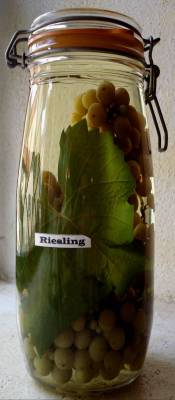
It's time to experiment.
Traditional or modern styles of German Rieslings?
It's all good!
Posted July 17 2008
By Daenna Van
Mulligen
Does the thought of drinking
Riesling for a solid week make you pause? Or does it make your mouth water in
anticipation – even knowing its acidity will have your palate waving the white
flag?
Wine weenies love Riesling.
Why? Because of its recognizable; honey, apricot, peach, citrus, apple, floral
and of course petrol aromas, its refreshing natural acidity - even when its
sweet - its natural affinity for various food pairing properties and its ability
to age. We’ve been predicting the Riesling renaissance for over a decade (if you
say it enough, people will believe it) but if you ask Germany it’s already
happening as the world increases its consumption of this noble variety.
There are some daunting consumer issues though. First, the German wine labels.
Its old news that they confuse the heck out of everyone. Even though German wine
labels are the most precise in the world - they not only tell you what the
wine is but how sweet it is and what village and region it is from.
But the classification on the labels also tell you its quality level, be it QbA,
QmP or the Cru status… (click here for more on the classifications)
It gets confusing – even for a professional.
Then there's the perception of poor quality
Riesling grapes
in a jar at Armin Diel
“sweet” wines. Wines that people remember
from
days gone by – wines that needn't enter into this equation.
I honestly believe, the
single most important thing to do is to drink these wonderful wines and not be
so concerned about all the labeling details. The more Riesling we drink, the
more that will appear on the shelves - quality Rieslings be they dry or off-dry.
And, while Germans themselves have moved on to drinking modern, bright, fragrant, dry
Rieslings, we, in North America, seem to be stuck in the sweet rut. Not that
sweet is bad, but we need to explore the dry Rieslings which pair so well with
fresh foods, cheese, seafood and our rich Asian food culture – especially in
British Columbia. Keep in mind that dry doesn’t mean cheek-sucking acidity and
lean fruit, but balanced, well-made fruity wines with soft, mouth-watering acidity.
Recently, I spent seven days
touring Germany from the Rheingau to Rheinhessen and then to the Pfalz.Mosel and Nahe
– that’s a lot of Riesling (with some Gewurztraminer, Pinot Blanc and Pinot Noir
thrown in for good measure) to taste. Each region has its own specific terroir,
style and charm.
In part 1 I’ll lead you through Rheingau .
The Rheingau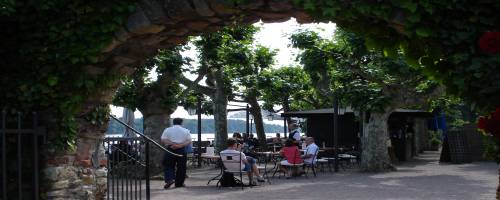
the outdoor terrace at Burg
Crass on the Rhein
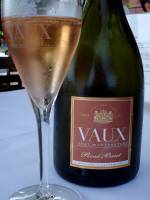
Burg Crass
Coffee and cake in the afternoon may be an integral part of the German lifestyle
but cake and wine was deemed a far more suitable way to start a recent tour of
Germany. After a red-eye flight from Vancouver (or Toronto) to Frankfurt our
small group of Canadian sommeliers and journalists parked our lagged carcasses
on a patio at Burg Crass in Eltville. The point was to decompress and to partake in strawberry and apple cake
with the local specialties - rosé and sekt (sparkling). Burg Crass is a well known
in this part of Germany. Its romantic location on the Rhine River is not far 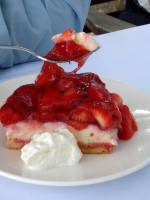
from the city of Mainz, and east of Hattenheim and
Erbach and our inn at Oestrich-Winkel. The word burg refers to a
fortified town or castle but now it’s been partially converted to a modern
restaurant and riverside terrace, the perfect indulgence for sunny weekend afternoons.
The Schloss Vaux Rosé Sekt (seen at right) was a delicious, crisp,
berry-laden sparkler, perfect for an alfresco afternoon, eating cake, by the
Rhine.
Schloss Vollrads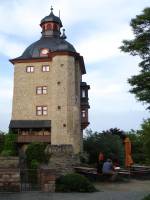
Considered to be the oldest
wine estate in Germany, Schloss Vollrads is identified by a stone tower
surrounded by a picturesque moat that was built in the beginning of the 14th
century.(see right)
The history of Vollrads is fascinating (records show wine sales from
1211) but unfortunately its status (despite attempts to rebuild) had diminished
in past decades until the entire site and vineyards were modernized in 1999 by a
savings trust after the last family member died in 1997.
All 58 hectares of
vineyards are planted with Riesling vines and the wines are now packaged in
distinguishable green fluted and scalloped bottles with glass stoppers.
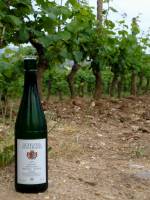
We enjoyed dinner that evening, in the shadow of the tower, on the patio at the
estate run Vinothek and Courtyard Terrace- a contemporary glass structure designed to integrate
with the ancient stone walls of Schloss Vollrads.
My favourite was the Schloss Vollrads Riesling Erstes Gewächs (click
here to see was EG means) 2005 - A ripe wine with unctuous aromas
of peaches, flowers and flint. Clean, fresh and off-dry with creamy stone fruit,
minerals and citrus.
The Schloss Vollrads wines are currently available in Ontario only.
Click here for the site and more
information.
Weingut Künstler
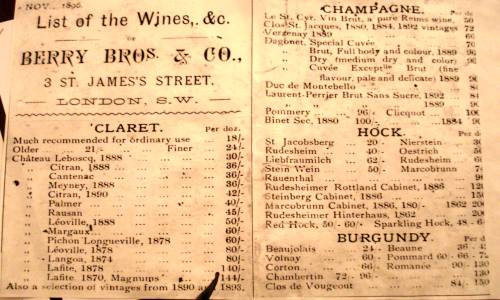
an 1896 document
showing the prices of great European wines
The entire Rheingau region has 3000 hectares – 300 of which are in the famed
Hochheim area. At one time Hochheim 'Hoch' (Rheingau Rieslings) were as revered and exclusive as those
great wines of Champagne, Burgundy and Bordeaux (above you’ll see a price
sheet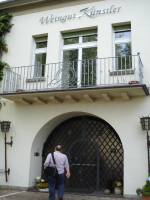 from 1896).
from 1896).
You’ll still see wines from this area labeled as
Hockenheimer.
Looking at this document I wish that now, the prices of those other great regions
listed were as
reasonable as those from Germany are.
Here, near Mainz in Hochheim along the Main River, is where you’ll find the 30 hectares
divided among half-a-dozen vineyards belonging to Weingut Künstler.
Gunter Künstler is a precise man who loves charts and (like his father before him) is
primarily a Riesling producer, but he also proudly attributes 15% of his
premium Reichestal vineyard to Spätburgunder (Pinot Noir). Gunter led us through
his various vineyards - typical, gently sloping Rheingau vineyards – soil types
playing to style, varietal and to his premium single vineyard designations.
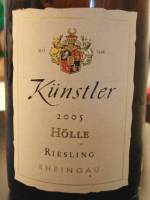 In
his Stielweg vineyard, gnarled Riesling vines over 50 years old produce
delicious traditional-style Auslese and TBA wines I was happy sample.
In
his Stielweg vineyard, gnarled Riesling vines over 50 years old produce
delicious traditional-style Auslese and TBA wines I was happy sample.
I found the modern-style Künstler wines to be clean and crisp, with power and
elegance.
The Kunstler Hölle Riesling, 2005 (at right) was powerful -
aromas of petrol, stone fruit and white citrus with beeswax, honey and an almost
nutty/savoury edge. Ripe and lush with a slightly oily palate this wine was
quite stunning.
Click here for the Kunstler
website.

Domdechant Werner
Literally, spitting (wine) distance from Künstler you'll find Domdechant
Werner.
Dr. Franz Werner Michel is 75 years old, going on 50. Energetic and trim he is
still running his estate with the assistance of one of his daughters. His home
is a lovely classical manor on the estate that has been home to generations,
including some very small ones
who prefer to play in the sandbox in the drive.
Started in 1780, the estate holds 12.5
hectares of classified 'first growth' vineyards (called
Erstes Gewächs)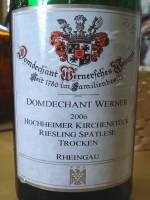 spread between his Domdechaney, Kirchenstük, Hölle and
Stein vineyards.
The estate produces the modern dry styles and traditionally sweeter Riesling
styles with 3% of the vineyards allocated to Spätburgunder (Pinot Noir).
spread between his Domdechaney, Kirchenstük, Hölle and
Stein vineyards.
The estate produces the modern dry styles and traditionally sweeter Riesling
styles with 3% of the vineyards allocated to Spätburgunder (Pinot Noir).
The
Domdechant Werner Hochheimer Hölle Riesling Kabinett 2007
is his basic, traditional-style Riesling for everyday drinking has light, fresh
aromas, orchard fruits, pear and apple with citrus and mineral notes. It's
easy drinking, off-dry with lime zest and a soft mouth-feel.
The 2006 is $19.95 in Ontario LCBO stores
The Domdechant
Werner Hochheimer Kirchenstük Riesling Spätlese Trocken, 2006 is a dry Spätlese,
crisp,floral and quite earthy with potent minerality.
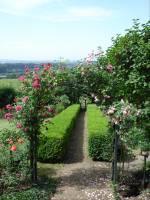
And his Domdechant Werner Hochheimer Kirchenstük Riesling Erstes Gewächs
2005 is a dry Auslese that's clean and minerally with apple and citrus
fruit. It shows power, elegance and mouth-watering acidity.
the gardens at the Domdechant Werner estate
To find out more on Domdechant Werner
click here
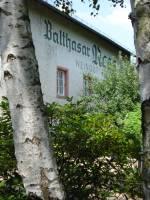
Balthasar Ress
I was excited, knowing that I was going to be visiting Balthasar Ress because
Ress are wines I've enjoyed drinking in the past several years. Available in BC, Manitoba and Ontario
(for certain), these wines are delicious and the
distinctive orange or green labels are very recognizable. Stephan Ress greeted us upon
arrival at the old winery with a glass of his wonderful 100% Pinot Noir
Balthasar Ress Sekt Blanc de Noirs Rose, 2004 with its fresh fruit,
floral and candied berry aromas.
Sadly its not available in Canada.
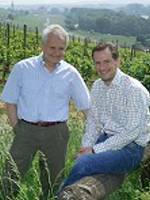
In 1870 Balthasar Ress himself, founded a catering business in Hattenheim which
sold its own wine. Stephan is the fourth generation Ress, his son Christian the
fifth and as of 1999 the two are co-owners of the company.
The Ress estate holds 42 hectares of vineyards in about a dozen vineyard sites.
They have a Vinotheque in the new winery and use the old, 17th century
farmhouse, that was the previous winery, for events like weddings and
receptions.
The first wine we tasted with Stephan was not actually part of the recognizable orange or green Ress
labels but rather the handsome black and silver "Von Unserm" label.
"Von Unserm" means
from Unserm, a special estate
Stephan Ress and son Christian Ress
which was chosen by Balthasar Ress
more than 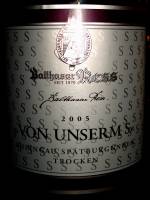
135 years ago.
Balthasar Ress "Von Unserm S" Rheingau Spätburgunder
Trocken, 2005 comes from vines that are more than 40 years old with
aromas of sour cherries and red berries, savoury herbal notes and leather with
hints of wood spice. It's medium-bodied with silky on the entry and flavours of
spiced, tart red fruits. The acidity is good and there are some youthful,
angular tannins on the finish.
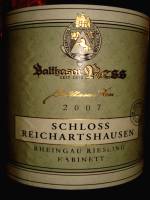
The 2004 Ress
Spätburgunder
Trocken is available in Ontario at LCBO stores for $14.95
And
from the four hectare Reichartshausen vineyard
which is solely farmed by Ress hails the Balthasar
Ress Schloss Reichartshausen Riesling Kabinett, 2007 with tree fruit, citrus
and chalk aromas. On the palate it's off-dry, with soft acidity and is very easy
drinking.
Balthasar Ress wines, available in BC

Balthasar Ress (orange label) Rheingau Riesling, 2006 - $15.99 in
BC
Balthasar Ress Hattenheimer Schutzenhaus, 2005 - the 2006 is a fragrant,
floral and honeyed wine with plenty of fresh, crisp tree fruit, mineral and
citrus with a lingering finish. $22.99 BC
Balthasar Ress Rheingau Riesling, 2006 (green label) $16+ private wine stores
Schloss Reinhartshausen
Not far from Balthasar Ress, in Erbach, is
Schloss Reinhartshausen.
Tucked in along the Rhein River, sits the castle,
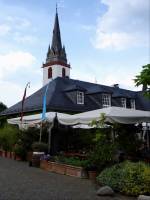
the winery, a lavish hotel, a lovely little tavern/restaurant and a vinoteque.
The estate is the largest privately owned estate in the Rheingau with over 80
hectares of vineyards (almost one-third of those are situated the Mariannenaue
Island in the middle of the Rhine a very short distance from the winery itself).
Reinhartshausen produces a substantial 30-35 wines, all different, 14 of which
we were happy to only taste after a long Riesling day.
The Restaurant at Schloss Reinhartshausen
Reinhartshausen does make a Pinot Noir which is a lean cold-climate style with
herbal and tart red fruit and a slightly astringent finish - like most German
wineries,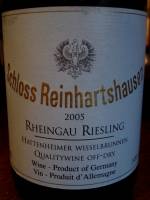 Riesling is their strength.
Riesling is their strength.
They also make an entry level screw-cap Riesling called Prinz von Preussen
(see availability below), the 2007 is off-dry, easy-drinking with rich
fruity aromas and fresh, clean acidity.
A favourite was the Schloss Reinhartshausen Hattenheimer Wisselbrunnen
Riesling, 2005 (right) with its rich tropical and honeyed fruit aromas,
creamy off-dry palate and fresh, soft acidity. The finish is surprisingly
powerful and a tad warm which shows its 14% alcohol.
(This wine is available in Manitoba)

The Schloss Reinhartshausen Erbach Marcobrunn Riesling
Erstes Gewächs, 2006
(at right shows the three windows at the bottom of the label which is the symbol
for Erstes Gewächs 'first growth') - a powerful dry Riesling with steely
minerality and mouth-watering acidity.
Available in BC
Prinz Von Preussen, 2006 - $19+ private stores
Prinz von Preussen, 2005 - $17+ private stores
Riesling Spatlese Erbacher Hohenrain, 2003- BCLDB $29.99
Riesling Auslese Erbacher Siegelsberg, 2003 - $50 private stores
Reinhartshausen Estate Riesling QbA, 2005 - BCLDB $19.99
Hattenheimer Nussbrunnen Riesling QbA, 2004 - $25+ private stores
Schloss Reinhartshausen wines are also available in Manitoba and Ontario
For more information of Schloss Reinhartshausen
click here
READ
GERMANY PART 2 - Rheinhessen, the Pfalz and Nahe
-end-
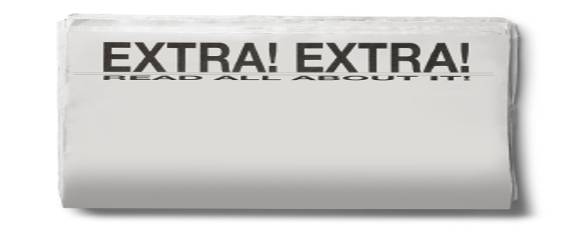







 from 1896).
from 1896).
 In
his Stielweg vineyard, gnarled Riesling vines over 50 years old produce
delicious traditional-style Auslese and TBA wines I was happy sample.
In
his Stielweg vineyard, gnarled Riesling vines over 50 years old produce
delicious traditional-style Auslese and TBA wines I was happy sample. 
 spread between his Domdechaney, Kirchenstük, H
spread between his Domdechaney, Kirchenstük, H






 Riesling is their strength.
Riesling is their strength. 